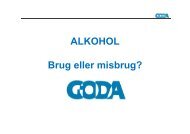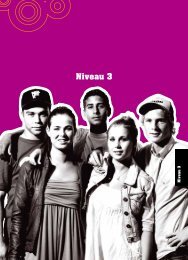Download Unge og risikovillighed - Alkoholdialog
Download Unge og risikovillighed - Alkoholdialog
Download Unge og risikovillighed - Alkoholdialog
Create successful ePaper yourself
Turn your PDF publications into a flip-book with our unique Google optimized e-Paper software.
<strong>Unge</strong> <strong>og</strong> <strong>risikovillighed</strong><br />
It is highly unrealistic and inappropriate to apply a<br />
prohibitionist de nition to describe drinking in the<br />
United States today. Perhaps we should de ne binge<br />
drinking as any intoxicated drinking that leads to cer-<br />
tain harmful or destructive behaviours. Perhaps we<br />
should at least require that a person have a certain<br />
minimum level of alcohol in the bloodstream as a<br />
prerequisite to be considered a binger. Perhaps we<br />
could even require that a person be intoxicated before<br />
being labelled a ’binger’. But one thing is certain:<br />
the unrealistic de nitions being promoted by some<br />
researchers are misleading and deceptive at best.<br />
The conclusion is clear: Be very sceptical the next<br />
time you hear or read a report about ’binge’ drin-<br />
king. Were the people in question really bingeing?<br />
By any reasonable de nition, most almost certainly<br />
were not.<br />
The Extent of Binge Drinking<br />
While a continuing barrage of newspaper articles,<br />
TV shows, and special interest group reports claim<br />
that binge drinking among young people is a growing<br />
epidemic, the actual fact is quite to the contrary. Binge<br />
drinking among young people is clearly declining and<br />
it has been doing so for many years.<br />
As seen in this image, ’binge’ drinking among high<br />
school seniors has declined from 41.2% to 27.9%<br />
between 1980 and 2003. That’s a drop of almost<br />
one-third (32.3%).<br />
Similarly, the proportion of U.S. military personnel who<br />
“binge” has also declined signi cantly, according to<br />
six worldwide surveys conducted for the military over<br />
a recently-ended 15-year period. 16 ’Binge’ drinking is<br />
also down among American college students, and<br />
16 Bray, R. M., et al. : Prevention in the military. In:Ammerman,<br />
R. T., et al. (Eds.). Prevention and Societal<br />
Impact of Drug and Alcohol Abuse. Lawrence Eribaum,<br />
1999<br />
28<br />
it has clearly been declining for a number of years.<br />
This is clear.<br />
For example, according to a recent study of college<br />
drinking by Dr. Henry Wechsler of Harvard University,<br />
“binge” drinking has decreased signi cantly across the<br />
country over the four years since his earlier study. His<br />
research also found that the proportion of abstainers<br />
jumped nearly 22% in that short period of time. 17<br />
These ndings are consistent with data collected for<br />
the National Institute on Drug Abuse by the Institute for<br />
Social Research (ISR) at the University of Michigan.<br />
The ISR research found that college “binge” drinking<br />
in the United States recently reached the lowest level<br />
of the entire 17-year period that its surveys have been<br />
conducted. Similarly, it found that the proportion of<br />
drinkers has reached an all-time low among college<br />
students. 18<br />
Research conducted at colleges across the United<br />
States repeatedly since the early 19805 by Drs.<br />
David Hanson (State University of New York) and<br />
Ruth Engs (Indiana University) has found declines<br />
over that time both in the proportion of collegians<br />
who drink at a high level and in the proportion who<br />
drink any alcohol.<br />
So the facts are clear. ’Binge’ drinking is down and<br />
abstinence is up among American college students.<br />
Yet in spite of this and other overwhelming evidence,<br />
the false impression persists that drinking is increasing<br />
and that “bingeing continues unabated.”<br />
So What’s The Harm?<br />
This misperception is dangerous because when<br />
young people go off to college falsely thinking that<br />
17 Wechsler, H., Dowdall, G. W., Maenner, G, Gledhill-<br />
Hoyt, J. And Lee, H. : Changes in binge drinking and<br />
related problems among American college students<br />
between 1993 and 1997. Journal of American College<br />
Health, 1998<br />
18 Institute for Social Research, University of Michigan,<br />
1999





